NUR219 Depression Case Study: Mental Health Assessment & Interventions
VerifiedAdded on 2023/06/12
|10
|3109
|369
Report
AI Summary
This case study focuses on the assessment and management of a patient named Berry, who presents with symptoms indicative of a mental health disorder. The report outlines key interpersonal skills a nurse should employ to build trust and effectively communicate with the patient, including empathy, active listening, and non-verbal communication. It identifies shortness of breath, troubled sleeping, and digestive issues as significant symptoms alerting to a potential mental health disorder, specifically depression and anxiety. The report proposes clinical interventions such as encouraging positive self-talk, therapeutic touch, and anxiety-reducing techniques like deep breathing. It also discusses the medication venlafaxine, including its mechanism of action and potential side effects, emphasizing the importance of patient education and monitoring. This document is available on Desklib, a platform providing various study tools for students, including solved assignments and past papers.
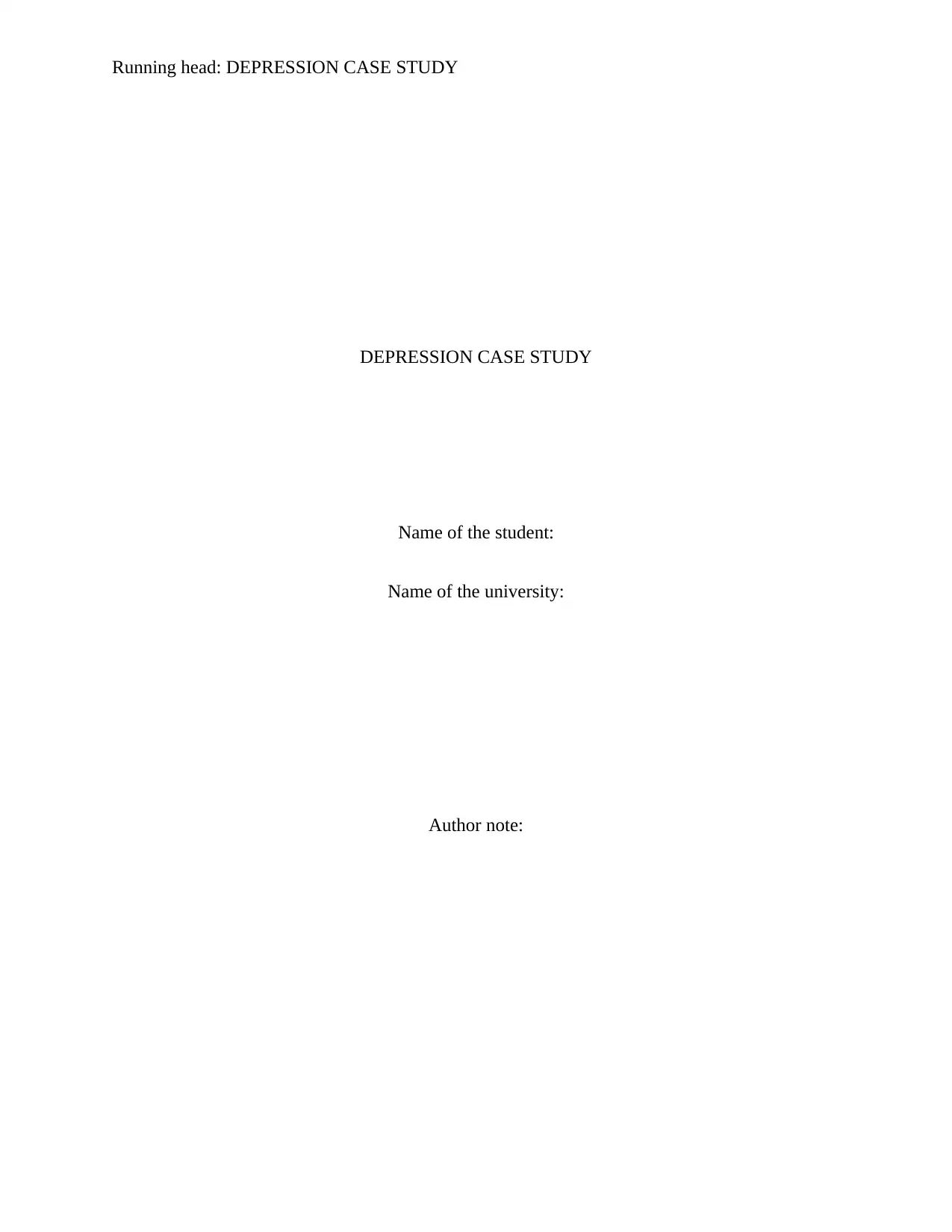
Running head: DEPRESSION CASE STUDY
DEPRESSION CASE STUDY
Name of the student:
Name of the university:
Author note:
DEPRESSION CASE STUDY
Name of the student:
Name of the university:
Author note:
Paraphrase This Document
Need a fresh take? Get an instant paraphrase of this document with our AI Paraphraser
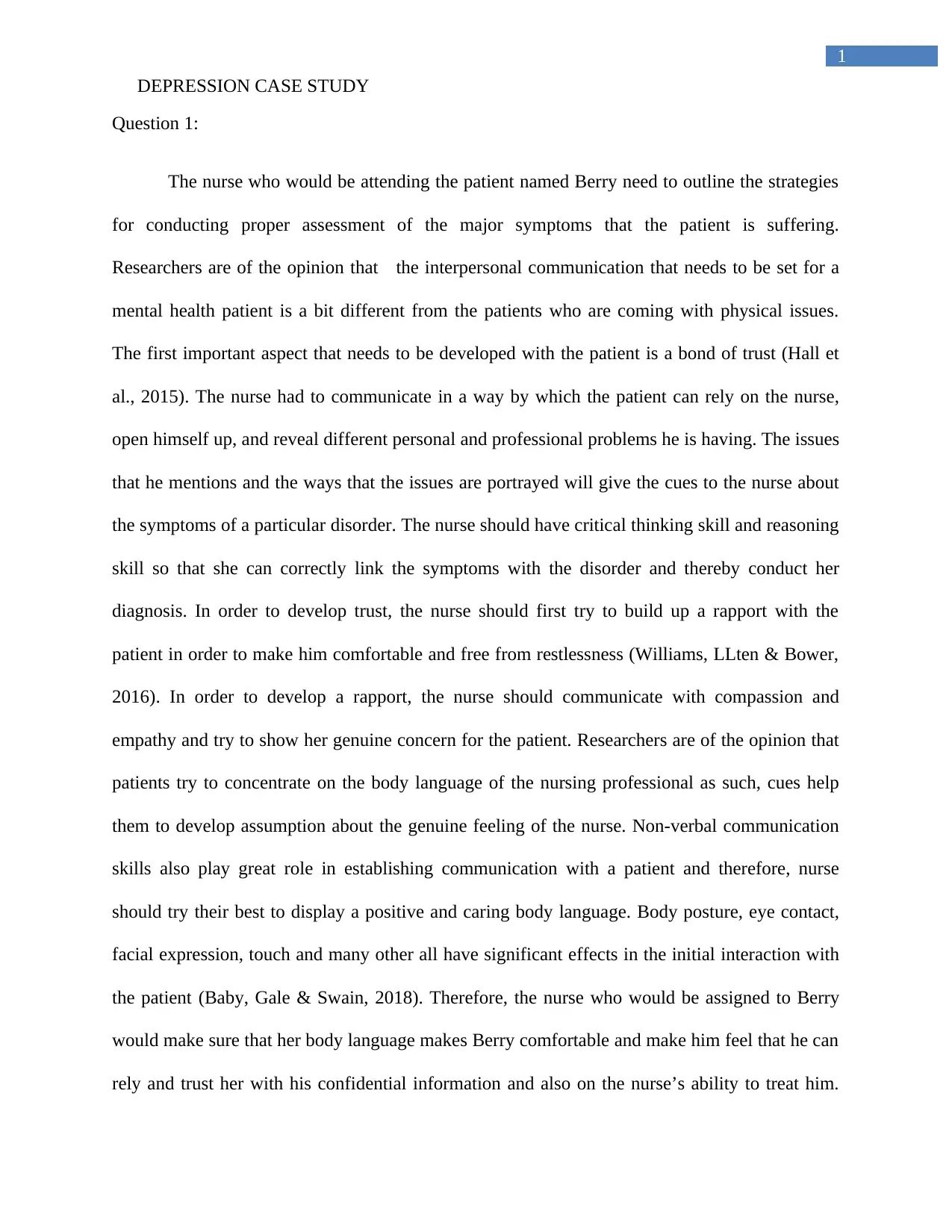
1
DEPRESSION CASE STUDY
Question 1:
The nurse who would be attending the patient named Berry need to outline the strategies
for conducting proper assessment of the major symptoms that the patient is suffering.
Researchers are of the opinion that the interpersonal communication that needs to be set for a
mental health patient is a bit different from the patients who are coming with physical issues.
The first important aspect that needs to be developed with the patient is a bond of trust (Hall et
al., 2015). The nurse had to communicate in a way by which the patient can rely on the nurse,
open himself up, and reveal different personal and professional problems he is having. The issues
that he mentions and the ways that the issues are portrayed will give the cues to the nurse about
the symptoms of a particular disorder. The nurse should have critical thinking skill and reasoning
skill so that she can correctly link the symptoms with the disorder and thereby conduct her
diagnosis. In order to develop trust, the nurse should first try to build up a rapport with the
patient in order to make him comfortable and free from restlessness (Williams, LLten & Bower,
2016). In order to develop a rapport, the nurse should communicate with compassion and
empathy and try to show her genuine concern for the patient. Researchers are of the opinion that
patients try to concentrate on the body language of the nursing professional as such, cues help
them to develop assumption about the genuine feeling of the nurse. Non-verbal communication
skills also play great role in establishing communication with a patient and therefore, nurse
should try their best to display a positive and caring body language. Body posture, eye contact,
facial expression, touch and many other all have significant effects in the initial interaction with
the patient (Baby, Gale & Swain, 2018). Therefore, the nurse who would be assigned to Berry
would make sure that her body language makes Berry comfortable and make him feel that he can
rely and trust her with his confidential information and also on the nurse’s ability to treat him.
DEPRESSION CASE STUDY
Question 1:
The nurse who would be attending the patient named Berry need to outline the strategies
for conducting proper assessment of the major symptoms that the patient is suffering.
Researchers are of the opinion that the interpersonal communication that needs to be set for a
mental health patient is a bit different from the patients who are coming with physical issues.
The first important aspect that needs to be developed with the patient is a bond of trust (Hall et
al., 2015). The nurse had to communicate in a way by which the patient can rely on the nurse,
open himself up, and reveal different personal and professional problems he is having. The issues
that he mentions and the ways that the issues are portrayed will give the cues to the nurse about
the symptoms of a particular disorder. The nurse should have critical thinking skill and reasoning
skill so that she can correctly link the symptoms with the disorder and thereby conduct her
diagnosis. In order to develop trust, the nurse should first try to build up a rapport with the
patient in order to make him comfortable and free from restlessness (Williams, LLten & Bower,
2016). In order to develop a rapport, the nurse should communicate with compassion and
empathy and try to show her genuine concern for the patient. Researchers are of the opinion that
patients try to concentrate on the body language of the nursing professional as such, cues help
them to develop assumption about the genuine feeling of the nurse. Non-verbal communication
skills also play great role in establishing communication with a patient and therefore, nurse
should try their best to display a positive and caring body language. Body posture, eye contact,
facial expression, touch and many other all have significant effects in the initial interaction with
the patient (Baby, Gale & Swain, 2018). Therefore, the nurse who would be assigned to Berry
would make sure that her body language makes Berry comfortable and make him feel that he can
rely and trust her with his confidential information and also on the nurse’s ability to treat him.
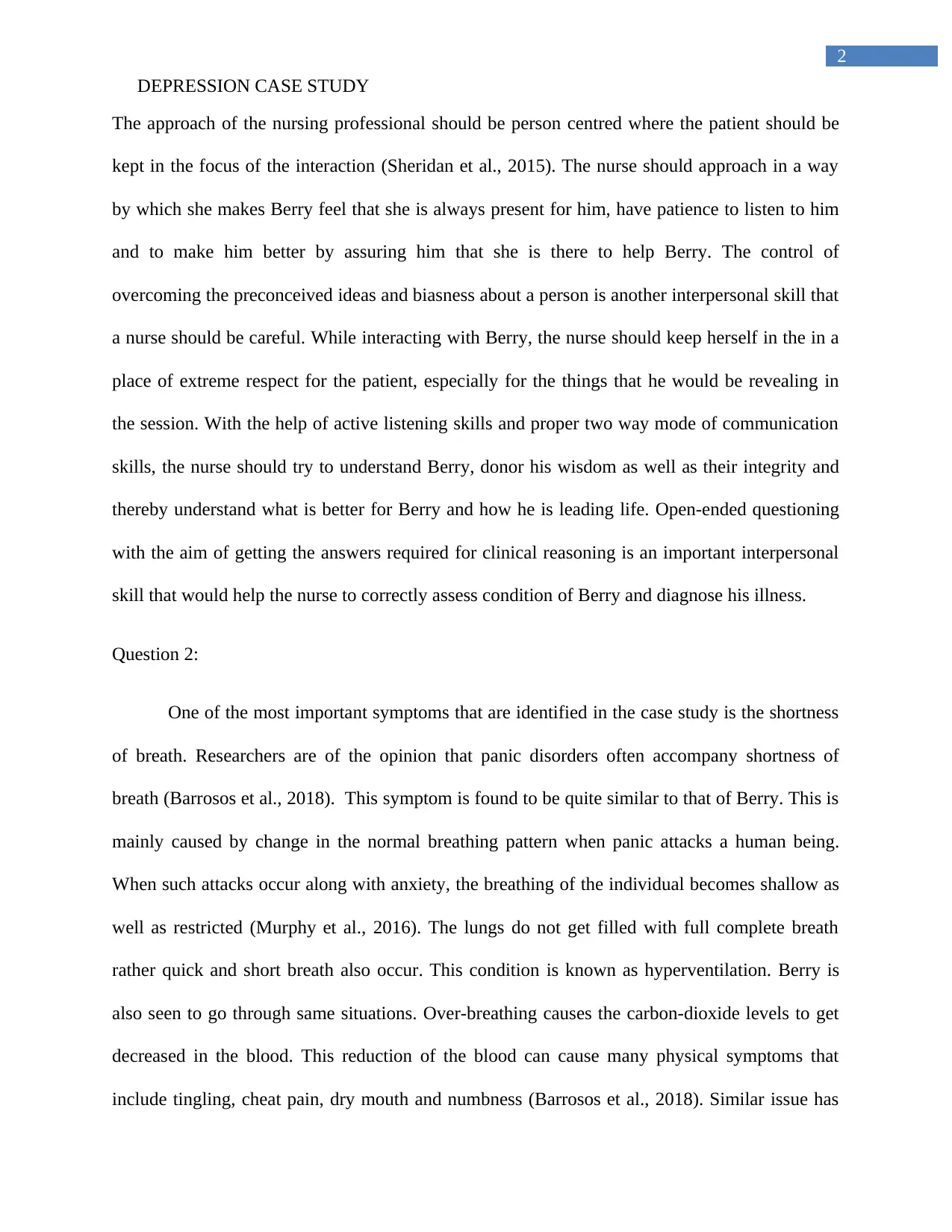
2
DEPRESSION CASE STUDY
The approach of the nursing professional should be person centred where the patient should be
kept in the focus of the interaction (Sheridan et al., 2015). The nurse should approach in a way
by which she makes Berry feel that she is always present for him, have patience to listen to him
and to make him better by assuring him that she is there to help Berry. The control of
overcoming the preconceived ideas and biasness about a person is another interpersonal skill that
a nurse should be careful. While interacting with Berry, the nurse should keep herself in the in a
place of extreme respect for the patient, especially for the things that he would be revealing in
the session. With the help of active listening skills and proper two way mode of communication
skills, the nurse should try to understand Berry, donor his wisdom as well as their integrity and
thereby understand what is better for Berry and how he is leading life. Open-ended questioning
with the aim of getting the answers required for clinical reasoning is an important interpersonal
skill that would help the nurse to correctly assess condition of Berry and diagnose his illness.
Question 2:
One of the most important symptoms that are identified in the case study is the shortness
of breath. Researchers are of the opinion that panic disorders often accompany shortness of
breath (Barrosos et al., 2018). This symptom is found to be quite similar to that of Berry. This is
mainly caused by change in the normal breathing pattern when panic attacks a human being.
When such attacks occur along with anxiety, the breathing of the individual becomes shallow as
well as restricted (Murphy et al., 2016). The lungs do not get filled with full complete breath
rather quick and short breath also occur. This condition is known as hyperventilation. Berry is
also seen to go through same situations. Over-breathing causes the carbon-dioxide levels to get
decreased in the blood. This reduction of the blood can cause many physical symptoms that
include tingling, cheat pain, dry mouth and numbness (Barrosos et al., 2018). Similar issue has
DEPRESSION CASE STUDY
The approach of the nursing professional should be person centred where the patient should be
kept in the focus of the interaction (Sheridan et al., 2015). The nurse should approach in a way
by which she makes Berry feel that she is always present for him, have patience to listen to him
and to make him better by assuring him that she is there to help Berry. The control of
overcoming the preconceived ideas and biasness about a person is another interpersonal skill that
a nurse should be careful. While interacting with Berry, the nurse should keep herself in the in a
place of extreme respect for the patient, especially for the things that he would be revealing in
the session. With the help of active listening skills and proper two way mode of communication
skills, the nurse should try to understand Berry, donor his wisdom as well as their integrity and
thereby understand what is better for Berry and how he is leading life. Open-ended questioning
with the aim of getting the answers required for clinical reasoning is an important interpersonal
skill that would help the nurse to correctly assess condition of Berry and diagnose his illness.
Question 2:
One of the most important symptoms that are identified in the case study is the shortness
of breath. Researchers are of the opinion that panic disorders often accompany shortness of
breath (Barrosos et al., 2018). This symptom is found to be quite similar to that of Berry. This is
mainly caused by change in the normal breathing pattern when panic attacks a human being.
When such attacks occur along with anxiety, the breathing of the individual becomes shallow as
well as restricted (Murphy et al., 2016). The lungs do not get filled with full complete breath
rather quick and short breath also occur. This condition is known as hyperventilation. Berry is
also seen to go through same situations. Over-breathing causes the carbon-dioxide levels to get
decreased in the blood. This reduction of the blood can cause many physical symptoms that
include tingling, cheat pain, dry mouth and numbness (Barrosos et al., 2018). Similar issue has
⊘ This is a preview!⊘
Do you want full access?
Subscribe today to unlock all pages.

Trusted by 1+ million students worldwide
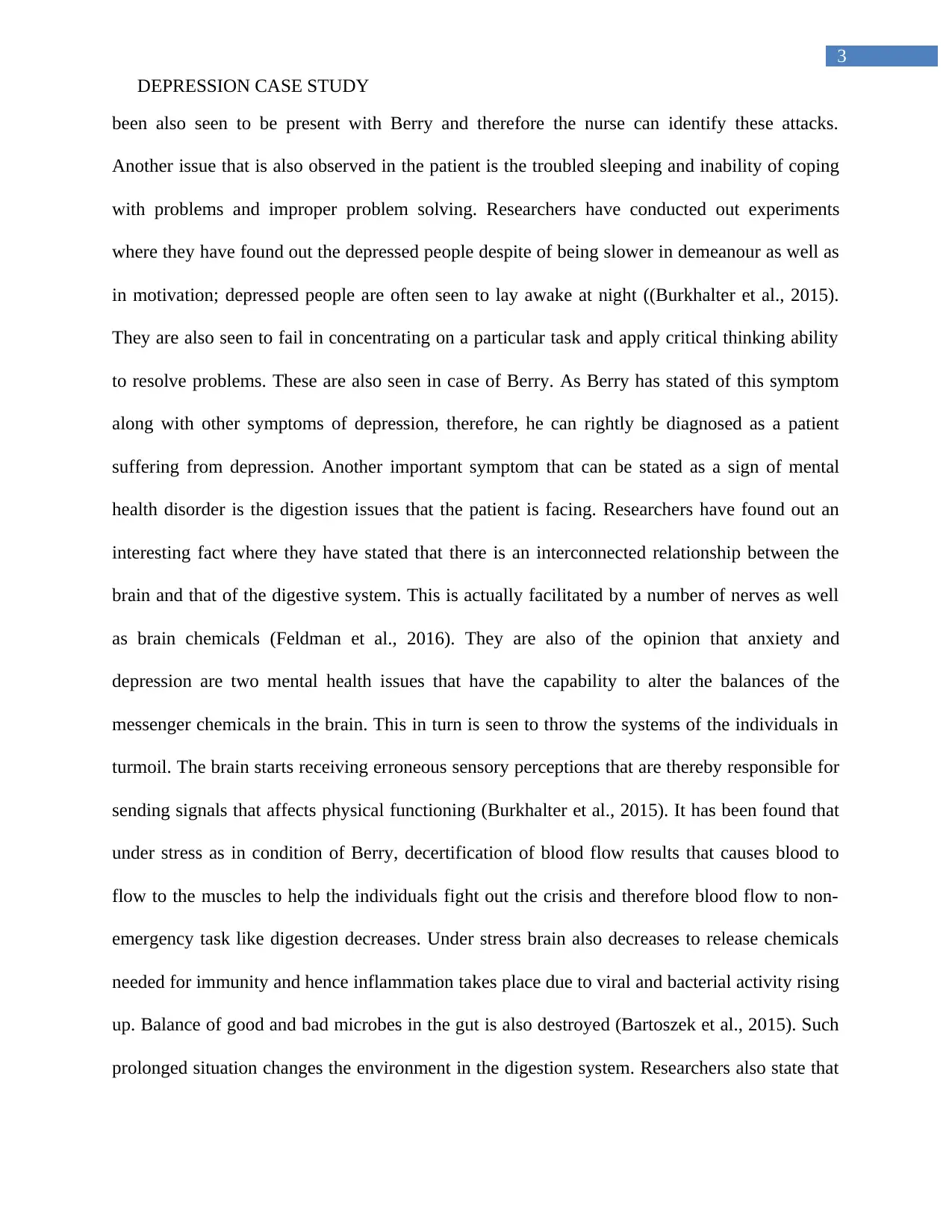
3
DEPRESSION CASE STUDY
been also seen to be present with Berry and therefore the nurse can identify these attacks.
Another issue that is also observed in the patient is the troubled sleeping and inability of coping
with problems and improper problem solving. Researchers have conducted out experiments
where they have found out the depressed people despite of being slower in demeanour as well as
in motivation; depressed people are often seen to lay awake at night ((Burkhalter et al., 2015).
They are also seen to fail in concentrating on a particular task and apply critical thinking ability
to resolve problems. These are also seen in case of Berry. As Berry has stated of this symptom
along with other symptoms of depression, therefore, he can rightly be diagnosed as a patient
suffering from depression. Another important symptom that can be stated as a sign of mental
health disorder is the digestion issues that the patient is facing. Researchers have found out an
interesting fact where they have stated that there is an interconnected relationship between the
brain and that of the digestive system. This is actually facilitated by a number of nerves as well
as brain chemicals (Feldman et al., 2016). They are also of the opinion that anxiety and
depression are two mental health issues that have the capability to alter the balances of the
messenger chemicals in the brain. This in turn is seen to throw the systems of the individuals in
turmoil. The brain starts receiving erroneous sensory perceptions that are thereby responsible for
sending signals that affects physical functioning (Burkhalter et al., 2015). It has been found that
under stress as in condition of Berry, decertification of blood flow results that causes blood to
flow to the muscles to help the individuals fight out the crisis and therefore blood flow to non-
emergency task like digestion decreases. Under stress brain also decreases to release chemicals
needed for immunity and hence inflammation takes place due to viral and bacterial activity rising
up. Balance of good and bad microbes in the gut is also destroyed (Bartoszek et al., 2015). Such
prolonged situation changes the environment in the digestion system. Researchers also state that
DEPRESSION CASE STUDY
been also seen to be present with Berry and therefore the nurse can identify these attacks.
Another issue that is also observed in the patient is the troubled sleeping and inability of coping
with problems and improper problem solving. Researchers have conducted out experiments
where they have found out the depressed people despite of being slower in demeanour as well as
in motivation; depressed people are often seen to lay awake at night ((Burkhalter et al., 2015).
They are also seen to fail in concentrating on a particular task and apply critical thinking ability
to resolve problems. These are also seen in case of Berry. As Berry has stated of this symptom
along with other symptoms of depression, therefore, he can rightly be diagnosed as a patient
suffering from depression. Another important symptom that can be stated as a sign of mental
health disorder is the digestion issues that the patient is facing. Researchers have found out an
interesting fact where they have stated that there is an interconnected relationship between the
brain and that of the digestive system. This is actually facilitated by a number of nerves as well
as brain chemicals (Feldman et al., 2016). They are also of the opinion that anxiety and
depression are two mental health issues that have the capability to alter the balances of the
messenger chemicals in the brain. This in turn is seen to throw the systems of the individuals in
turmoil. The brain starts receiving erroneous sensory perceptions that are thereby responsible for
sending signals that affects physical functioning (Burkhalter et al., 2015). It has been found that
under stress as in condition of Berry, decertification of blood flow results that causes blood to
flow to the muscles to help the individuals fight out the crisis and therefore blood flow to non-
emergency task like digestion decreases. Under stress brain also decreases to release chemicals
needed for immunity and hence inflammation takes place due to viral and bacterial activity rising
up. Balance of good and bad microbes in the gut is also destroyed (Bartoszek et al., 2015). Such
prolonged situation changes the environment in the digestion system. Researchers also state that
Paraphrase This Document
Need a fresh take? Get an instant paraphrase of this document with our AI Paraphraser
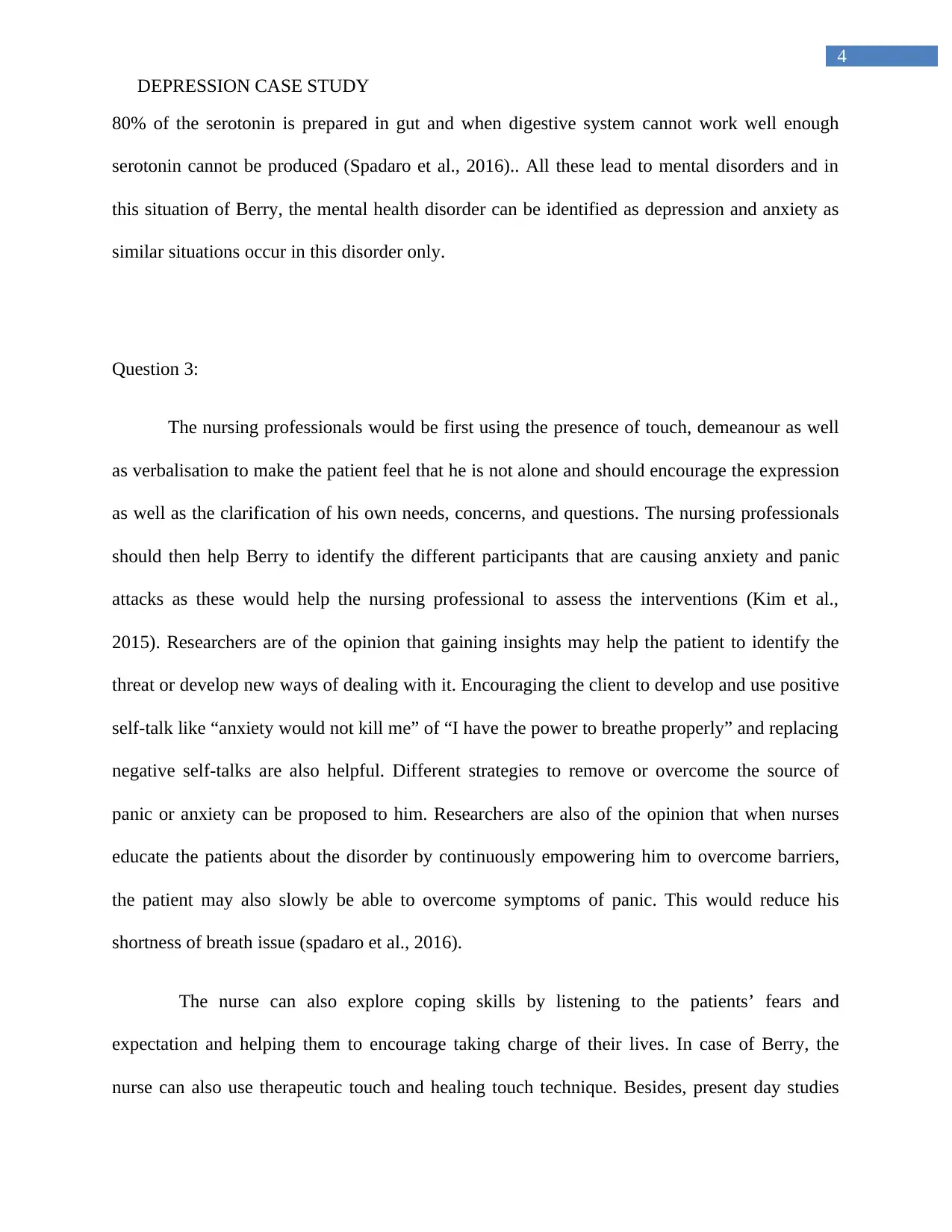
4
DEPRESSION CASE STUDY
80% of the serotonin is prepared in gut and when digestive system cannot work well enough
serotonin cannot be produced (Spadaro et al., 2016).. All these lead to mental disorders and in
this situation of Berry, the mental health disorder can be identified as depression and anxiety as
similar situations occur in this disorder only.
Question 3:
The nursing professionals would be first using the presence of touch, demeanour as well
as verbalisation to make the patient feel that he is not alone and should encourage the expression
as well as the clarification of his own needs, concerns, and questions. The nursing professionals
should then help Berry to identify the different participants that are causing anxiety and panic
attacks as these would help the nursing professional to assess the interventions (Kim et al.,
2015). Researchers are of the opinion that gaining insights may help the patient to identify the
threat or develop new ways of dealing with it. Encouraging the client to develop and use positive
self-talk like “anxiety would not kill me” of “I have the power to breathe properly” and replacing
negative self-talks are also helpful. Different strategies to remove or overcome the source of
panic or anxiety can be proposed to him. Researchers are also of the opinion that when nurses
educate the patients about the disorder by continuously empowering him to overcome barriers,
the patient may also slowly be able to overcome symptoms of panic. This would reduce his
shortness of breath issue (spadaro et al., 2016).
The nurse can also explore coping skills by listening to the patients’ fears and
expectation and helping them to encourage taking charge of their lives. In case of Berry, the
nurse can also use therapeutic touch and healing touch technique. Besides, present day studies
DEPRESSION CASE STUDY
80% of the serotonin is prepared in gut and when digestive system cannot work well enough
serotonin cannot be produced (Spadaro et al., 2016).. All these lead to mental disorders and in
this situation of Berry, the mental health disorder can be identified as depression and anxiety as
similar situations occur in this disorder only.
Question 3:
The nursing professionals would be first using the presence of touch, demeanour as well
as verbalisation to make the patient feel that he is not alone and should encourage the expression
as well as the clarification of his own needs, concerns, and questions. The nursing professionals
should then help Berry to identify the different participants that are causing anxiety and panic
attacks as these would help the nursing professional to assess the interventions (Kim et al.,
2015). Researchers are of the opinion that gaining insights may help the patient to identify the
threat or develop new ways of dealing with it. Encouraging the client to develop and use positive
self-talk like “anxiety would not kill me” of “I have the power to breathe properly” and replacing
negative self-talks are also helpful. Different strategies to remove or overcome the source of
panic or anxiety can be proposed to him. Researchers are also of the opinion that when nurses
educate the patients about the disorder by continuously empowering him to overcome barriers,
the patient may also slowly be able to overcome symptoms of panic. This would reduce his
shortness of breath issue (spadaro et al., 2016).
The nurse can also explore coping skills by listening to the patients’ fears and
expectation and helping them to encourage taking charge of their lives. In case of Berry, the
nurse can also use therapeutic touch and healing touch technique. Besides, present day studies
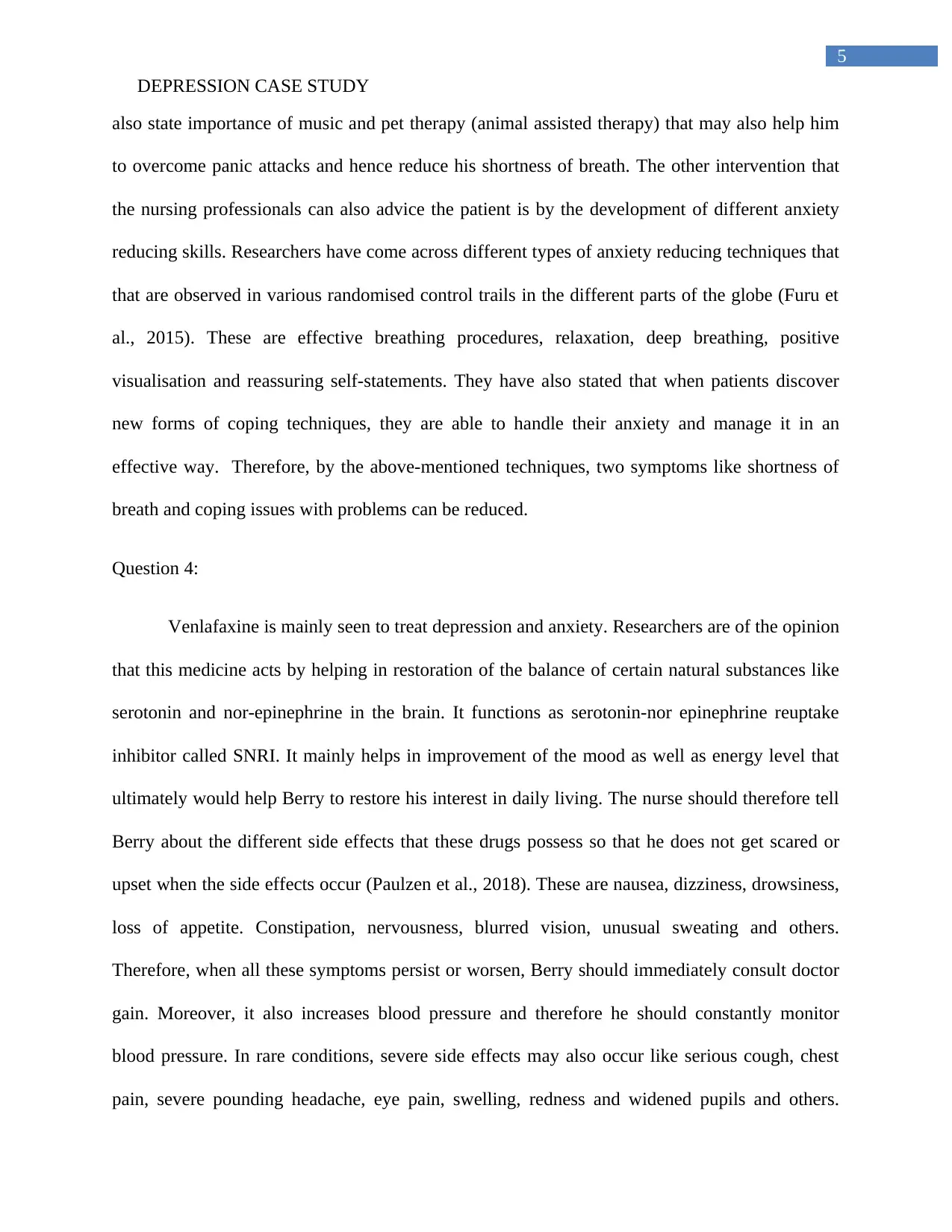
5
DEPRESSION CASE STUDY
also state importance of music and pet therapy (animal assisted therapy) that may also help him
to overcome panic attacks and hence reduce his shortness of breath. The other intervention that
the nursing professionals can also advice the patient is by the development of different anxiety
reducing skills. Researchers have come across different types of anxiety reducing techniques that
that are observed in various randomised control trails in the different parts of the globe (Furu et
al., 2015). These are effective breathing procedures, relaxation, deep breathing, positive
visualisation and reassuring self-statements. They have also stated that when patients discover
new forms of coping techniques, they are able to handle their anxiety and manage it in an
effective way. Therefore, by the above-mentioned techniques, two symptoms like shortness of
breath and coping issues with problems can be reduced.
Question 4:
Venlafaxine is mainly seen to treat depression and anxiety. Researchers are of the opinion
that this medicine acts by helping in restoration of the balance of certain natural substances like
serotonin and nor-epinephrine in the brain. It functions as serotonin-nor epinephrine reuptake
inhibitor called SNRI. It mainly helps in improvement of the mood as well as energy level that
ultimately would help Berry to restore his interest in daily living. The nurse should therefore tell
Berry about the different side effects that these drugs possess so that he does not get scared or
upset when the side effects occur (Paulzen et al., 2018). These are nausea, dizziness, drowsiness,
loss of appetite. Constipation, nervousness, blurred vision, unusual sweating and others.
Therefore, when all these symptoms persist or worsen, Berry should immediately consult doctor
gain. Moreover, it also increases blood pressure and therefore he should constantly monitor
blood pressure. In rare conditions, severe side effects may also occur like serious cough, chest
pain, severe pounding headache, eye pain, swelling, redness and widened pupils and others.
DEPRESSION CASE STUDY
also state importance of music and pet therapy (animal assisted therapy) that may also help him
to overcome panic attacks and hence reduce his shortness of breath. The other intervention that
the nursing professionals can also advice the patient is by the development of different anxiety
reducing skills. Researchers have come across different types of anxiety reducing techniques that
that are observed in various randomised control trails in the different parts of the globe (Furu et
al., 2015). These are effective breathing procedures, relaxation, deep breathing, positive
visualisation and reassuring self-statements. They have also stated that when patients discover
new forms of coping techniques, they are able to handle their anxiety and manage it in an
effective way. Therefore, by the above-mentioned techniques, two symptoms like shortness of
breath and coping issues with problems can be reduced.
Question 4:
Venlafaxine is mainly seen to treat depression and anxiety. Researchers are of the opinion
that this medicine acts by helping in restoration of the balance of certain natural substances like
serotonin and nor-epinephrine in the brain. It functions as serotonin-nor epinephrine reuptake
inhibitor called SNRI. It mainly helps in improvement of the mood as well as energy level that
ultimately would help Berry to restore his interest in daily living. The nurse should therefore tell
Berry about the different side effects that these drugs possess so that he does not get scared or
upset when the side effects occur (Paulzen et al., 2018). These are nausea, dizziness, drowsiness,
loss of appetite. Constipation, nervousness, blurred vision, unusual sweating and others.
Therefore, when all these symptoms persist or worsen, Berry should immediately consult doctor
gain. Moreover, it also increases blood pressure and therefore he should constantly monitor
blood pressure. In rare conditions, severe side effects may also occur like serious cough, chest
pain, severe pounding headache, eye pain, swelling, redness and widened pupils and others.
⊘ This is a preview!⊘
Do you want full access?
Subscribe today to unlock all pages.

Trusted by 1+ million students worldwide
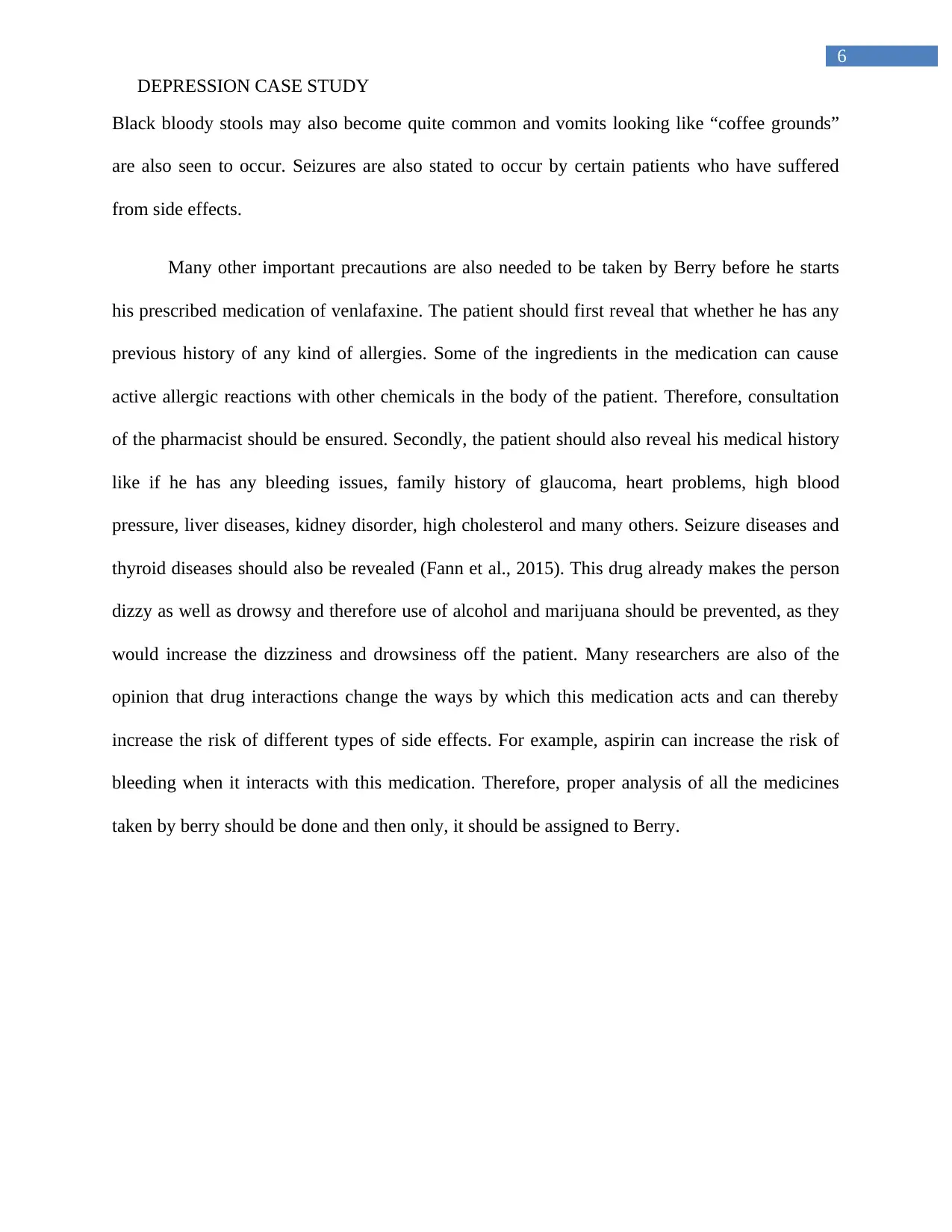
6
DEPRESSION CASE STUDY
Black bloody stools may also become quite common and vomits looking like “coffee grounds”
are also seen to occur. Seizures are also stated to occur by certain patients who have suffered
from side effects.
Many other important precautions are also needed to be taken by Berry before he starts
his prescribed medication of venlafaxine. The patient should first reveal that whether he has any
previous history of any kind of allergies. Some of the ingredients in the medication can cause
active allergic reactions with other chemicals in the body of the patient. Therefore, consultation
of the pharmacist should be ensured. Secondly, the patient should also reveal his medical history
like if he has any bleeding issues, family history of glaucoma, heart problems, high blood
pressure, liver diseases, kidney disorder, high cholesterol and many others. Seizure diseases and
thyroid diseases should also be revealed (Fann et al., 2015). This drug already makes the person
dizzy as well as drowsy and therefore use of alcohol and marijuana should be prevented, as they
would increase the dizziness and drowsiness off the patient. Many researchers are also of the
opinion that drug interactions change the ways by which this medication acts and can thereby
increase the risk of different types of side effects. For example, aspirin can increase the risk of
bleeding when it interacts with this medication. Therefore, proper analysis of all the medicines
taken by berry should be done and then only, it should be assigned to Berry.
DEPRESSION CASE STUDY
Black bloody stools may also become quite common and vomits looking like “coffee grounds”
are also seen to occur. Seizures are also stated to occur by certain patients who have suffered
from side effects.
Many other important precautions are also needed to be taken by Berry before he starts
his prescribed medication of venlafaxine. The patient should first reveal that whether he has any
previous history of any kind of allergies. Some of the ingredients in the medication can cause
active allergic reactions with other chemicals in the body of the patient. Therefore, consultation
of the pharmacist should be ensured. Secondly, the patient should also reveal his medical history
like if he has any bleeding issues, family history of glaucoma, heart problems, high blood
pressure, liver diseases, kidney disorder, high cholesterol and many others. Seizure diseases and
thyroid diseases should also be revealed (Fann et al., 2015). This drug already makes the person
dizzy as well as drowsy and therefore use of alcohol and marijuana should be prevented, as they
would increase the dizziness and drowsiness off the patient. Many researchers are also of the
opinion that drug interactions change the ways by which this medication acts and can thereby
increase the risk of different types of side effects. For example, aspirin can increase the risk of
bleeding when it interacts with this medication. Therefore, proper analysis of all the medicines
taken by berry should be done and then only, it should be assigned to Berry.
Paraphrase This Document
Need a fresh take? Get an instant paraphrase of this document with our AI Paraphraser
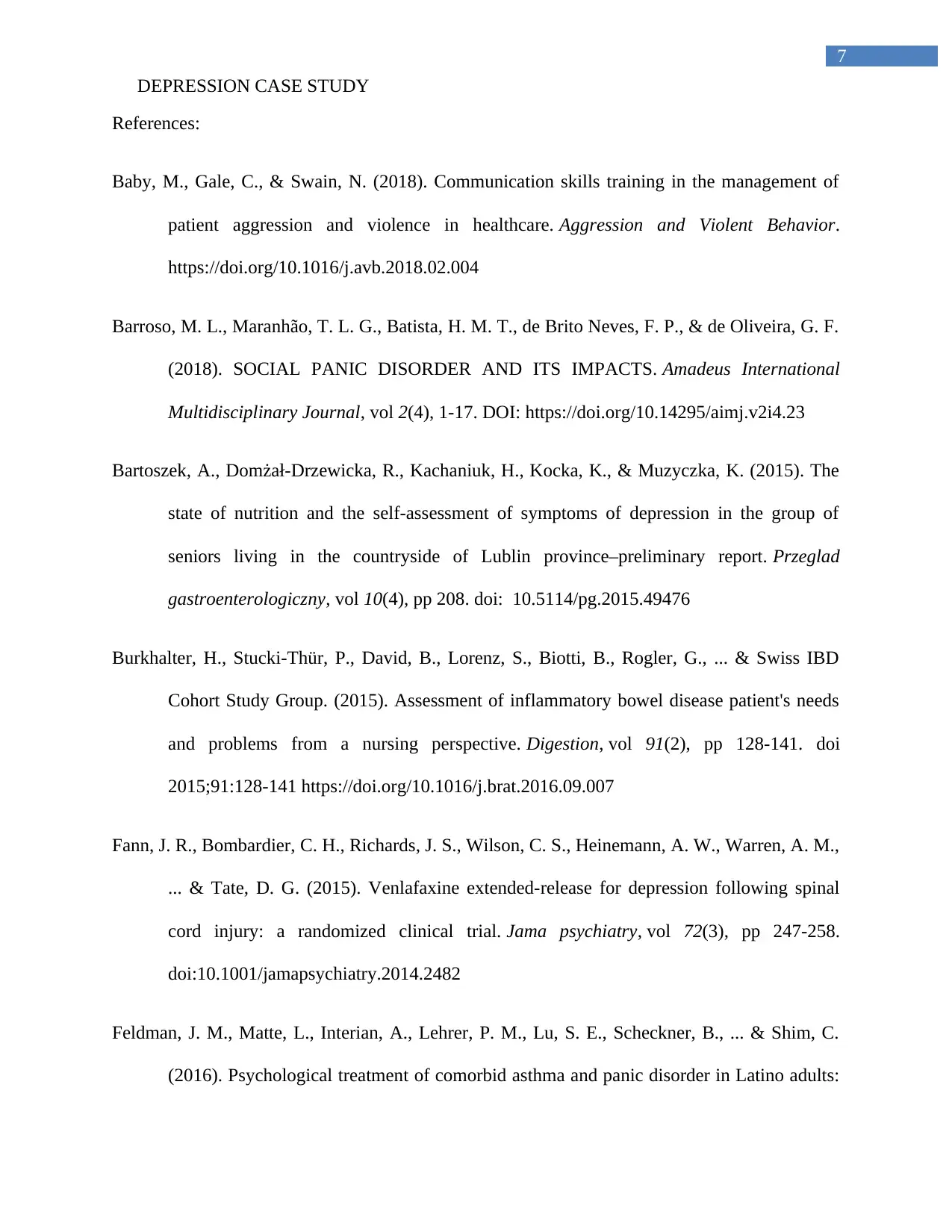
7
DEPRESSION CASE STUDY
References:
Baby, M., Gale, C., & Swain, N. (2018). Communication skills training in the management of
patient aggression and violence in healthcare. Aggression and Violent Behavior.
https://doi.org/10.1016/j.avb.2018.02.004
Barroso, M. L., Maranhão, T. L. G., Batista, H. M. T., de Brito Neves, F. P., & de Oliveira, G. F.
(2018). SOCIAL PANIC DISORDER AND ITS IMPACTS. Amadeus International
Multidisciplinary Journal, vol 2(4), 1-17. DOI: https://doi.org/10.14295/aimj.v2i4.23
Bartoszek, A., Domżał-Drzewicka, R., Kachaniuk, H., Kocka, K., & Muzyczka, K. (2015). The
state of nutrition and the self-assessment of symptoms of depression in the group of
seniors living in the countryside of Lublin province–preliminary report. Przeglad
gastroenterologiczny, vol 10(4), pp 208. doi: 10.5114/pg.2015.49476
Burkhalter, H., Stucki-Thür, P., David, B., Lorenz, S., Biotti, B., Rogler, G., ... & Swiss IBD
Cohort Study Group. (2015). Assessment of inflammatory bowel disease patient's needs
and problems from a nursing perspective. Digestion, vol 91(2), pp 128-141. doi
2015;91:128-141 https://doi.org/10.1016/j.brat.2016.09.007
Fann, J. R., Bombardier, C. H., Richards, J. S., Wilson, C. S., Heinemann, A. W., Warren, A. M.,
... & Tate, D. G. (2015). Venlafaxine extended-release for depression following spinal
cord injury: a randomized clinical trial. Jama psychiatry, vol 72(3), pp 247-258.
doi:10.1001/jamapsychiatry.2014.2482
Feldman, J. M., Matte, L., Interian, A., Lehrer, P. M., Lu, S. E., Scheckner, B., ... & Shim, C.
(2016). Psychological treatment of comorbid asthma and panic disorder in Latino adults:
DEPRESSION CASE STUDY
References:
Baby, M., Gale, C., & Swain, N. (2018). Communication skills training in the management of
patient aggression and violence in healthcare. Aggression and Violent Behavior.
https://doi.org/10.1016/j.avb.2018.02.004
Barroso, M. L., Maranhão, T. L. G., Batista, H. M. T., de Brito Neves, F. P., & de Oliveira, G. F.
(2018). SOCIAL PANIC DISORDER AND ITS IMPACTS. Amadeus International
Multidisciplinary Journal, vol 2(4), 1-17. DOI: https://doi.org/10.14295/aimj.v2i4.23
Bartoszek, A., Domżał-Drzewicka, R., Kachaniuk, H., Kocka, K., & Muzyczka, K. (2015). The
state of nutrition and the self-assessment of symptoms of depression in the group of
seniors living in the countryside of Lublin province–preliminary report. Przeglad
gastroenterologiczny, vol 10(4), pp 208. doi: 10.5114/pg.2015.49476
Burkhalter, H., Stucki-Thür, P., David, B., Lorenz, S., Biotti, B., Rogler, G., ... & Swiss IBD
Cohort Study Group. (2015). Assessment of inflammatory bowel disease patient's needs
and problems from a nursing perspective. Digestion, vol 91(2), pp 128-141. doi
2015;91:128-141 https://doi.org/10.1016/j.brat.2016.09.007
Fann, J. R., Bombardier, C. H., Richards, J. S., Wilson, C. S., Heinemann, A. W., Warren, A. M.,
... & Tate, D. G. (2015). Venlafaxine extended-release for depression following spinal
cord injury: a randomized clinical trial. Jama psychiatry, vol 72(3), pp 247-258.
doi:10.1001/jamapsychiatry.2014.2482
Feldman, J. M., Matte, L., Interian, A., Lehrer, P. M., Lu, S. E., Scheckner, B., ... & Shim, C.
(2016). Psychological treatment of comorbid asthma and panic disorder in Latino adults:
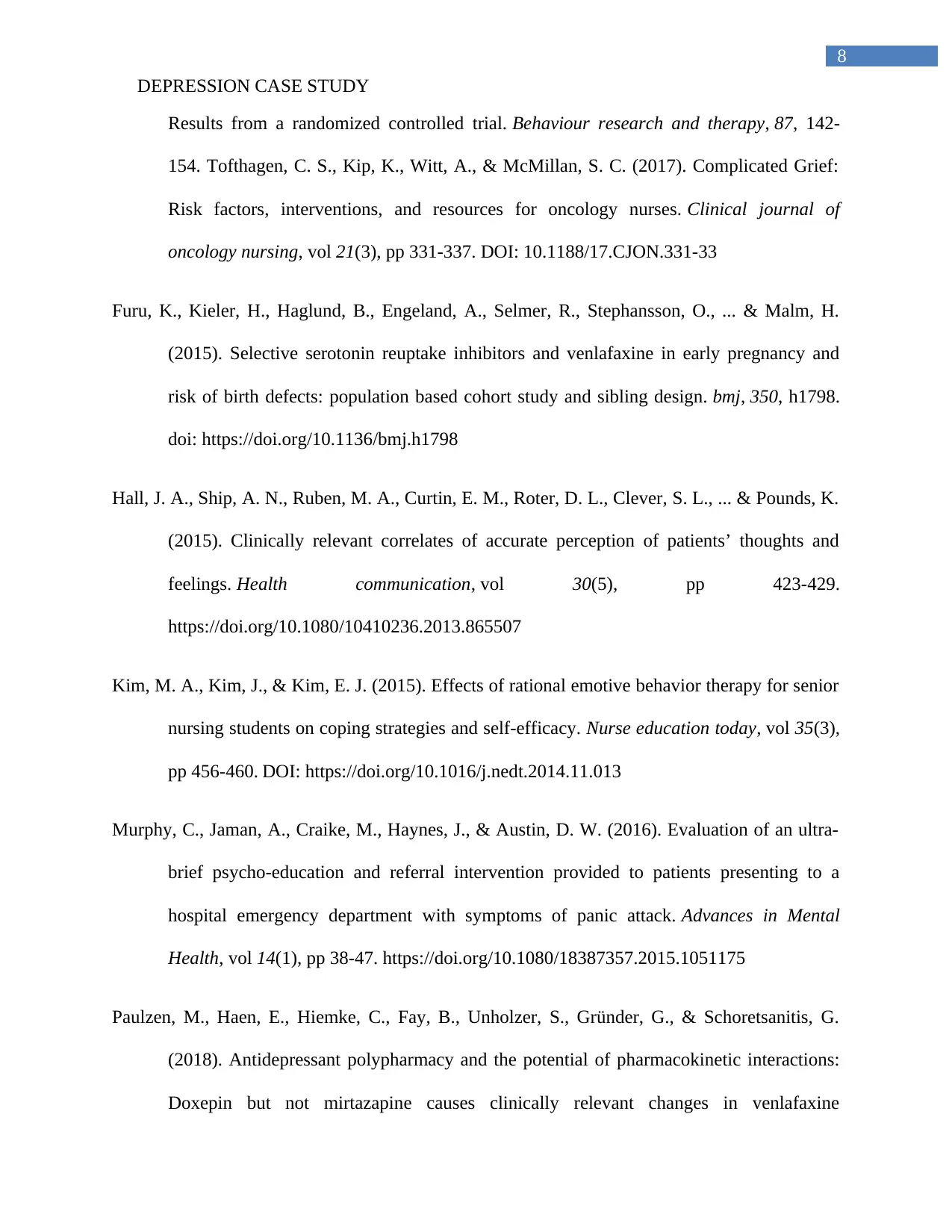
8
DEPRESSION CASE STUDY
Results from a randomized controlled trial. Behaviour research and therapy, 87, 142-
154. Tofthagen, C. S., Kip, K., Witt, A., & McMillan, S. C. (2017). Complicated Grief:
Risk factors, interventions, and resources for oncology nurses. Clinical journal of
oncology nursing, vol 21(3), pp 331-337. DOI: 10.1188/17.CJON.331-33
Furu, K., Kieler, H., Haglund, B., Engeland, A., Selmer, R., Stephansson, O., ... & Malm, H.
(2015). Selective serotonin reuptake inhibitors and venlafaxine in early pregnancy and
risk of birth defects: population based cohort study and sibling design. bmj, 350, h1798.
doi: https://doi.org/10.1136/bmj.h1798
Hall, J. A., Ship, A. N., Ruben, M. A., Curtin, E. M., Roter, D. L., Clever, S. L., ... & Pounds, K.
(2015). Clinically relevant correlates of accurate perception of patients’ thoughts and
feelings. Health communication, vol 30(5), pp 423-429.
https://doi.org/10.1080/10410236.2013.865507
Kim, M. A., Kim, J., & Kim, E. J. (2015). Effects of rational emotive behavior therapy for senior
nursing students on coping strategies and self-efficacy. Nurse education today, vol 35(3),
pp 456-460. DOI: https://doi.org/10.1016/j.nedt.2014.11.013
Murphy, C., Jaman, A., Craike, M., Haynes, J., & Austin, D. W. (2016). Evaluation of an ultra-
brief psycho-education and referral intervention provided to patients presenting to a
hospital emergency department with symptoms of panic attack. Advances in Mental
Health, vol 14(1), pp 38-47. https://doi.org/10.1080/18387357.2015.1051175
Paulzen, M., Haen, E., Hiemke, C., Fay, B., Unholzer, S., Gründer, G., & Schoretsanitis, G.
(2018). Antidepressant polypharmacy and the potential of pharmacokinetic interactions:
Doxepin but not mirtazapine causes clinically relevant changes in venlafaxine
DEPRESSION CASE STUDY
Results from a randomized controlled trial. Behaviour research and therapy, 87, 142-
154. Tofthagen, C. S., Kip, K., Witt, A., & McMillan, S. C. (2017). Complicated Grief:
Risk factors, interventions, and resources for oncology nurses. Clinical journal of
oncology nursing, vol 21(3), pp 331-337. DOI: 10.1188/17.CJON.331-33
Furu, K., Kieler, H., Haglund, B., Engeland, A., Selmer, R., Stephansson, O., ... & Malm, H.
(2015). Selective serotonin reuptake inhibitors and venlafaxine in early pregnancy and
risk of birth defects: population based cohort study and sibling design. bmj, 350, h1798.
doi: https://doi.org/10.1136/bmj.h1798
Hall, J. A., Ship, A. N., Ruben, M. A., Curtin, E. M., Roter, D. L., Clever, S. L., ... & Pounds, K.
(2015). Clinically relevant correlates of accurate perception of patients’ thoughts and
feelings. Health communication, vol 30(5), pp 423-429.
https://doi.org/10.1080/10410236.2013.865507
Kim, M. A., Kim, J., & Kim, E. J. (2015). Effects of rational emotive behavior therapy for senior
nursing students on coping strategies and self-efficacy. Nurse education today, vol 35(3),
pp 456-460. DOI: https://doi.org/10.1016/j.nedt.2014.11.013
Murphy, C., Jaman, A., Craike, M., Haynes, J., & Austin, D. W. (2016). Evaluation of an ultra-
brief psycho-education and referral intervention provided to patients presenting to a
hospital emergency department with symptoms of panic attack. Advances in Mental
Health, vol 14(1), pp 38-47. https://doi.org/10.1080/18387357.2015.1051175
Paulzen, M., Haen, E., Hiemke, C., Fay, B., Unholzer, S., Gründer, G., & Schoretsanitis, G.
(2018). Antidepressant polypharmacy and the potential of pharmacokinetic interactions:
Doxepin but not mirtazapine causes clinically relevant changes in venlafaxine
⊘ This is a preview!⊘
Do you want full access?
Subscribe today to unlock all pages.

Trusted by 1+ million students worldwide
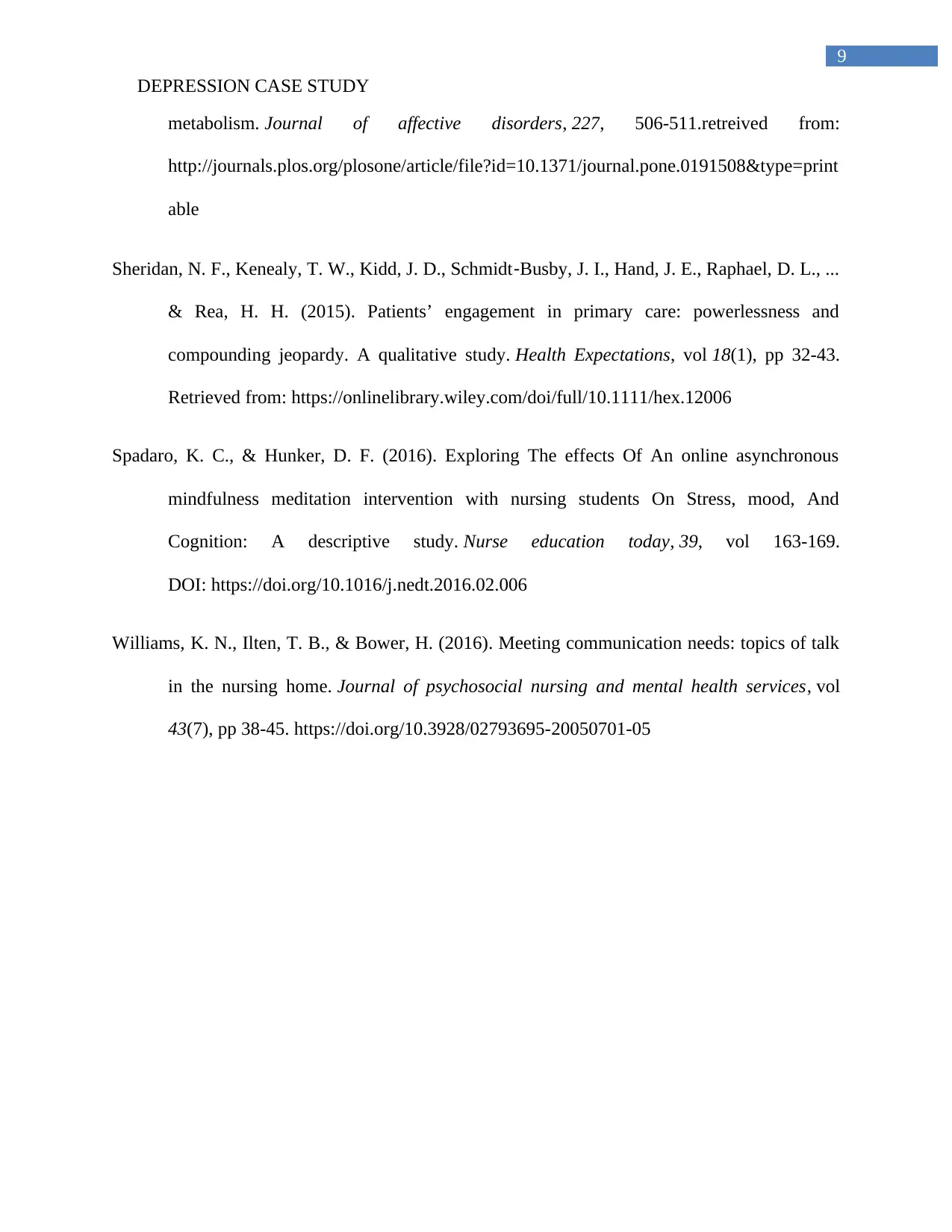
9
DEPRESSION CASE STUDY
metabolism. Journal of affective disorders, 227, 506-511.retreived from:
http://journals.plos.org/plosone/article/file?id=10.1371/journal.pone.0191508&type=print
able
Sheridan, N. F., Kenealy, T. W., Kidd, J. D., Schmidt‐Busby, J. I., Hand, J. E., Raphael, D. L., ...
& Rea, H. H. (2015). Patients’ engagement in primary care: powerlessness and
compounding jeopardy. A qualitative study. Health Expectations, vol 18(1), pp 32-43.
Retrieved from: https://onlinelibrary.wiley.com/doi/full/10.1111/hex.12006
Spadaro, K. C., & Hunker, D. F. (2016). Exploring The effects Of An online asynchronous
mindfulness meditation intervention with nursing students On Stress, mood, And
Cognition: A descriptive study. Nurse education today, 39, vol 163-169.
DOI: https://doi.org/10.1016/j.nedt.2016.02.006
Williams, K. N., Ilten, T. B., & Bower, H. (2016). Meeting communication needs: topics of talk
in the nursing home. Journal of psychosocial nursing and mental health services, vol
43(7), pp 38-45. https://doi.org/10.3928/02793695-20050701-05
DEPRESSION CASE STUDY
metabolism. Journal of affective disorders, 227, 506-511.retreived from:
http://journals.plos.org/plosone/article/file?id=10.1371/journal.pone.0191508&type=print
able
Sheridan, N. F., Kenealy, T. W., Kidd, J. D., Schmidt‐Busby, J. I., Hand, J. E., Raphael, D. L., ...
& Rea, H. H. (2015). Patients’ engagement in primary care: powerlessness and
compounding jeopardy. A qualitative study. Health Expectations, vol 18(1), pp 32-43.
Retrieved from: https://onlinelibrary.wiley.com/doi/full/10.1111/hex.12006
Spadaro, K. C., & Hunker, D. F. (2016). Exploring The effects Of An online asynchronous
mindfulness meditation intervention with nursing students On Stress, mood, And
Cognition: A descriptive study. Nurse education today, 39, vol 163-169.
DOI: https://doi.org/10.1016/j.nedt.2016.02.006
Williams, K. N., Ilten, T. B., & Bower, H. (2016). Meeting communication needs: topics of talk
in the nursing home. Journal of psychosocial nursing and mental health services, vol
43(7), pp 38-45. https://doi.org/10.3928/02793695-20050701-05
1 out of 10
Related Documents
Your All-in-One AI-Powered Toolkit for Academic Success.
+13062052269
info@desklib.com
Available 24*7 on WhatsApp / Email
![[object Object]](/_next/static/media/star-bottom.7253800d.svg)
Unlock your academic potential
Copyright © 2020–2025 A2Z Services. All Rights Reserved. Developed and managed by ZUCOL.





